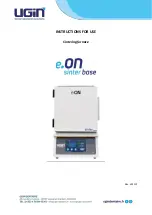
508093-01
Issue 2033
Page 22 of 59
If any motor fails the below tests, do not install the new
control module. The motor is defective and it also must be
replaced. The new control can fail if placed on a defective
motor.
1.
Using an ohmmeter check the resistance from any
one of the motor connector pins to the aluminum end
plate of the motor. This resistance should be greater
than 100k ohms.
2.
Check the resistances between each of the three motor
connector pins. These should all read approximately
the same resistance within an ohm.
3.
Check to see if the blower wheel spins freely.
Figure 17. Motor Test
Scale
Measurement Range in Words
ohms
2 M
two megohms - two million ohms
0 - 2,000,000
200 K
two hundred kil-ohms -
two hundred thousand ohms
0 - 200,000
20 K
twenty kilo-ohms -
twenty thousand ohms
0 - 20,000
2 K
two kilo-ohms -
two-thousand ohms
0 - 2,000
200
two hundred ohms
0 - 200
Motor Module Installation
All replacement motor control modules look similar;
however, each module is designed for a specific motor
size. It is very important to make sure that you are using the
correct replacement motor control module.
USE OF THE
WRONG MOTOR CONTROL MODULE MAY RESULT IN
UNEXPECTED UNIT OPERATION.
1.
Verify electrical power to unit is disconnected.
2.
Connect three-wire harness from motor to control
module.
3.
Mount new motor
control module to
motor using two hex
head bolts. Torque
bolts to 22 inch pounds
or 1/16th clock turn as
exampled to the right.
1
2
3
4
5
6
7
8
9
10
1112
1/16
TURN
4.
Reconnect the two
harnesses to the motor
control module.
5.
The electrical connectors of the motor should be
facing down to form a drip loop (Figure 18). This will
directs moisture away from the motor and its electric
connections on the motor.
Figure 18.
Drip Loop
CONNECTOR
ORIENTATION
BETWEEN 4 AND 8
O'CLOCK
BACK OF CONTROL
MODULE
DRIP LOOP















































